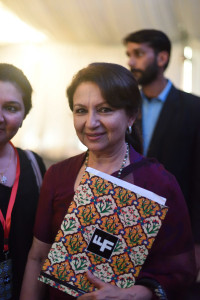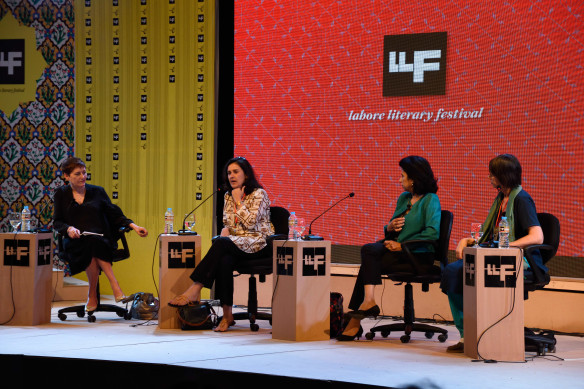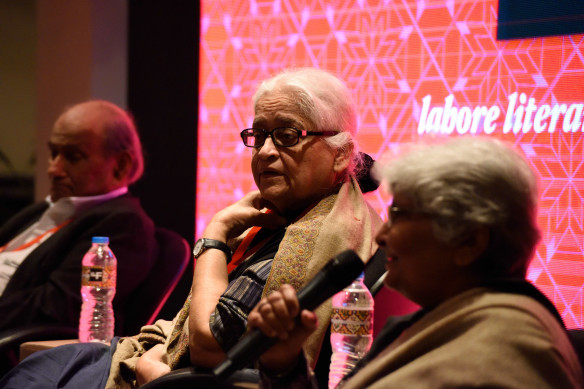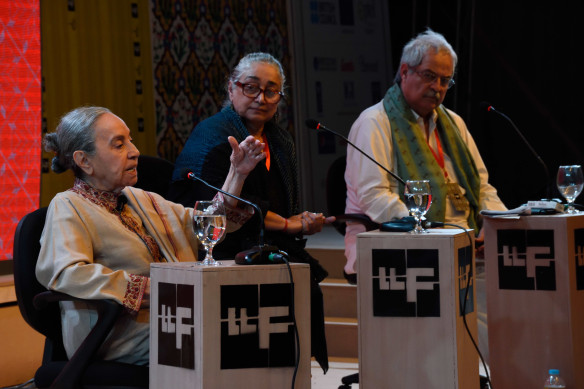From Global to Local
By Raza Naeem | Arts & Culture | Books | Published 8 years ago
Like 2015, the 2016 edition of the Lahore Literature Festival (LLF) hovered on the brink of cancellation. Whether due to the ubiquitous ‘security reasons’ or the rumours that the Punjab Chief Minister was displeased at the opposition of some of the members of the LLF organising committee to his Orange Metro Line project in Lahore, the LLF did, in fact, go ahead, but at the cost of a shift to a venue which even at the best of times was struggling to cope with the influx of participants, and a much-truncated two-day programme shortened from its intended three-day format.
Having the LLF at a hastily-conceived, last-minute enclosed space — though not the fault of the organisers — meant that the new venue excluded many would-be participants who simply could not be accommodated in the overflowing sessions that characterised each of the two days of the LLF.
Some of the sessions at the LLF this year were well-thought of, especially the ones commemorating literary legend Intizar Husain, who passed away just weeks before the event; the iconic Pakistani painter Anwar Jalal Shemza; Allama Iqbal, Mir Taqi Mir and even Quratulain Hyder’s most powerful novel Aag ka Darya. However, there were some irrelevant additions and shocking misses, giving one the impression that perhaps the organisers of the LLF are too keen to pander to a western audience like its local counterparts in Karachi and Lahore, despite being located in Pakistan’s cultural and culinary capital. It was heartening to see more panels on various aspects of Urdu literature being part of the LLF this year, but the one or two token panels on Punjabi and Seraiki languages, which were part of the original three-day programme were dropped.
Also, what will be remembered for a long time will be the insult to injury caused by the fact that there was no session to commemorate the death of a titan of Punjabi resistance poetry, Nasreen Anjum Bhatti, who passed away a few days before Intizar Husain. One also does not understand how adding panels on David Bowie, George Orwell or Virginia Woolf without contextualising the relevance of their work for South Asia could have helped? In addition, 2016 marks the birth centenary of three legendary Pakistani luminaries, the Progressive writers Sibte Hasan and Ahmad Nadeem Qasmi, and the iconic painter Shakir Ali, none of whom was remembered at LLF 2016, neither a passing reference was made to them; ironically both Qasmi and Ali are sons of Lahore.
 Sharmila Tagore, who opened the event, talked warmly about her relationships with the two key men in her life, Satyajit Ray, one of the fathers of Indian realist cinema, and Nawab Mansur Ali Pataudi, the cricketer who eventually became her husband. When asked to give a final message to Lahore, she said, “It’s wonderful that we share a wonderful cultural past. There should be a free exchange of ideas; it may not change attitudes, but influence them. Politics may create tension, but cultural diplomacy must continue. From Farida Khanum to Coke Studio, and from Dhoop Kinaray to Zindagi Channel, they are so so popular in India and all our young children follow Pakistani fashion and food. These forums are very very important.”
Sharmila Tagore, who opened the event, talked warmly about her relationships with the two key men in her life, Satyajit Ray, one of the fathers of Indian realist cinema, and Nawab Mansur Ali Pataudi, the cricketer who eventually became her husband. When asked to give a final message to Lahore, she said, “It’s wonderful that we share a wonderful cultural past. There should be a free exchange of ideas; it may not change attitudes, but influence them. Politics may create tension, but cultural diplomacy must continue. From Farida Khanum to Coke Studio, and from Dhoop Kinaray to Zindagi Channel, they are so so popular in India and all our young children follow Pakistani fashion and food. These forums are very very important.”
The session on Intizar Husain was ably moderated by Masood Ashar and it aptly became a celebration of the former’s long life rather than mourning his death. Kishwar Naheed wittily recounted how, while Husain would himself never approach a woman and offer to converse with her, he kept a woman inside him which he didn’t want to reveal, while Ikramullah revealed that Husain’s initial disdain for communists and Progressives eventually began to change and he came to respect others’ right to their opinion. Literary critic Nasir Abbas Nayyer said that Intizar Husain was the first postcolonial writer in whose work the whole experience of colonialism and a creative response to it is present. However, it is difficult to agree with Ashar when he remarked that Husain was the only writer in Urdu who had excelled in every genre he touched. I think Husain’s fellow Lahorite Qasmi, whose birth centenary is being celebrated this year, also fits that description since the latter excelled in the short story, poetry, novella and column-writing.
The session on Quratulain Hyder’s classic novel Aag ka Darya (River of Fire) on the first day of LLF was one of the most entertaining sessions at the festival. It was a surprisingly jam-packed session, more so than the one on Intizar Husain; perhaps Hyder’s fiery reputation had preceded her. The discussion began by noting that the novel is indeed one of Urdu literature’s greatest novels, and in fact can hold its own when pitted against the best of world literature. The discussion then moved on to the fact that like many other Urdu writers, Hyder was also cursed by her best-known novel in that it marred the discussion of the rest of her work, which was equally important. Indeed, quite a lot of the best Urdu literature was heavily influenced by the novel, including iconic novels like Intizar Husain’s Basti and Abdullah Hussain’s Udas Naslein. Arfa Syeda Zahra noted pithily about the novel that, “When fire and river synthesise, culture and history are born. There are no men and women in the novel; the central character of the novel is time.” According to her, the central questions of the novel were the nature and limits of independence, and where will the individual who is subsumed by these forces obtain an answer to that question? It was also interesting to know the amount of critique heaped onto the novel upon its publication, which later on spilled over into a critique of her private life and legendary spinsterhood.
In a festival marred by a surfeit of sessions on current affairs and politics, a stand-out session was on the Arab Spring, subtitled ‘A Frank Obituary.’ Despite the fact that the panel had interesting voices from Palestine, Egypt and Iran, the quality of the discussion was marred by the moderator Dr Farzana Shaikh, not only because of her lack of knowledge about the region, but by her tendency to monopolise and dominate the discussion (she did the same in another session on the second day of the LLF while interviewing former Kyrgyz president, Roza Otunbayeva). Nevertheless, the session was made livelier by the articulate thoughts of the Egyptian-American Mona Eltahawy, who was sexually assaulted by the Egyptian security forces at the height of the uprising against Hosni Mubarak. None of the panelists agreed with the rather dismal title of the panel and agreed that the term ‘Arab Spring’ was a deeply flawed term, since the process was still fluid. In addition, there was a consensus that the uprisings are about ‘imagining the impossible’ and what they had achieved was to break people’s fear and empowered them. The panel also disagreed with the moderator’s attempts to describe the process as caught between reformists and conservatives, and brought in external intervention in the region as another factor. A more imaginative moderator would have also discussed the role of poetry, art and literature in the region following the upheaval, since it is often poets who give hope and voice to the dispossessed.
Another interesting session on the first day of the LLF was on ‘Feminism and Global Politics.’ The panel suffered from the absence of one of our own, Rafia Zakaria, but was strengthened by the perspectives from countries as diverse as Egypt, India and Bangladesh. The moderator, Rachel Holmes opened the discussion by observing that feminism was the oldest democratic movement in the world, and surprisingly non-violent in character. Eltahawy, the Egyptian panelist, seemed to continue from where she had left off in her previous session, beginning her description of Egyptian women’s position in Sisi’s Egypt with a four-letter expletive and then ending provocatively with the challenge, “Stay out of my vagina unless I want you in there!”, again winning the audience’s thunderous approval. Dina Siddiqi, the Bangladeshi academic brought in the role of feminism as the handmaiden of empire in the United States and questioned recent British overtures to appropriate the language of feminism, referring to the recent initiative by the British prime minister to launch a fund to teach immigrant Muslim women English to decrease militancy. Anita Anand shed light on the most interesting case of Sapphire, a daughter of the last Sikh ruler of Lahore, Maharaja Ranjit Singh who was born and bred in Britain and after living a highly privileged life there, turned into a ‘fighting, battling suffragette’ after herself experiencing racism during a visit to British India. The session ended on some important observations that gender and sexuality are modes of controlling population and creating differences among them; that feminism is not simply about gender equality but also about people of different classes, thus not given over to homogenisation; and that there doesn’t have to be a choice between racism and sexism.
A treat for lovers of Urdu literature was the session on the legendary 18th century Urdu poet Mir Taqi Mir subtitled ‘Shakhsiyat aur Shairi.’ The session was astonishing in its ability to bring together the solid academic expertise of Professors Khurshid Rizvi and C.M. Naim, the feminist consciousness of Zehra Nigah, the political persona of Aitzaz Ahsan and the placidity of the moderator, the distinguished poet Amjad Islam Amjad. Amjad began the session by noting that every era in the subcontinent had one representative poet beginning with Mir in the 18th century; Ghalib in the 19th century; and Iqbal in the 20th century.
Naim talked about the sheer prodigiousness of Mir, who in addition to his poetry, also composed three masnavis, three shikarnamas and even a poem on his beloved cat. However our textbooks reflect only a selection of Mir’s poetry. Naim also cautioned against reading the personality of the poet in his poetry, rather he advised one to look at Mir over his entire life. He also discussed the poet’s early life which was lived in great turmoil, having being orphaned at an early age, also sharing that the account of the poet going mad in his autobiography is actually an embellishment, far from the truth.
Nigah had a refreshingly different take on Mir, believing that the poet’s personality could not be separated from his poetry, and that many of his couplets transmitted his personality. She remarked that Mir was a very conceited person, never learning sycophancy at all. According to her, the conceit is there in his poetry. The second point which she made was that even unlettered minds could enjoy the language of Mir’s poetry.
Nigah further highlighted the abundance of boys as subjects of Mir, as well as the fact that he wrote against the qazi and the mufti, but he was neither jailed nor charged with blasphemy. Aitzaz Ahsan brought Mir’s poetry into its cultural and historical perspective, noting that the poet was witness to some important events like Nadir Shah’s sack of Delhi, as well as Ahmad Shah Abdali’s subsequent attack on the city, temporarily leaving to go to Lucknow. He also witnessed the restoration of order by the British. According to Ahsan, it was because of these events that Mir’s poetry had pathos and melancholy; even his romantic poetry was not free of it. In this sense, Mir’s poetry was unique, for neither Ghalib nor Iqbal ever witnessed such violence. Rizvi noted that Mir’s poetry was full of life and instead of writing in elite language, the latter adopted popular expression.
Ahsan summed up the session by remarking that we should study the pathos, imagery, simplicity and the short poem in Mir’s poetry and compare it with English Romantic poets like Shelley and Keats. The jam-packed session, with the younger lot even occupying the floor is front of the dais, was evidence of not only the enduring popularity of Mir but also the finesse with which the moderator carried off the whole session.
Professor Naim’s two sessions on ‘Old Urdu Journals’ and ‘Urdu Mystery Literature’ were the surprise package of this year’s LLF. Despite reading from an ostensibly academic paper in both sessions, the talks managed to reveal fascinating, often startling, details. For example, where else would one have known that as late as 1901 the issue of European bahus (daughters-in-law) was still considered important enough to merit a mention inTehzeeb-e-Niswan? Or that one of the readers of Pandit Ratan Nath Sarshar, the creator of Fasana-e-Azadwould ask his favourite author to publish the details of his travel expenditure? Or that the nationalist poet who is credited with dreaming up Pakistan would be writing an ad for quality green tea in 1931?
The session on Urdu mystery novels was also a revelation. The spy novels in Urdu, according to Naim, were more about investigation than spying, and the hero was always an upper-class male. He traced the history of Urdu mystery novels from 1900 with early translations of the novels of G.W. Reynolds and Eugene Sue. According to Naim, these novels were available on train junctions like their English counterparts and could be taken home to read by anyone regardless of class, upon payment. The first important name in this regard was Zafar Umar whose translation Neeli Chatri was based on Maurice Leblanc’s novel in an Indian setting and became very popular. The main character was a student from Aligarh like Umar and based on a real-life character there nicknamed Masood ‘Tommy.’ Another distinguished name in mystery literature is Tirath Ram Ferozepuri, who translated 140 novels. However, following Partition, he had to migrate to India, leaving his entire output in Lahore, which he never got back. According to Naim, Umar’s creative translations and Ferozepuri’s actual translations are still in print. He concluded the session by observing that mystery novels are now popularly thought of as entertainment but until the 1930s, these were read very seriously and also provided a moral education.
On a final note, there were performances of A. R. Gurney’s play Love Letters on both days of the LLF featuring Rehana Saigol and Imran Aslam as the two protagonists who wrote love letters to each other over a 50-year period. Urdu letters has its own fine epistolary tradition whether it be Saadat Hasan Manto’s Letters to Uncle Sam, or Qazi Abdul Ghaffar’s Laila kay Khutoot, or even the love letters exchanged between Faiz and his wife Alys; and between the poet Jan Nisar Akhtar and his wife Safia. Perhaps it would have been better to seek to dramatise these and showcase the rich literary culture of Lahore, rather than mimicking the literary festivals of the West?
Despite the organisers managing to pull the LLF off successfully this year, which some would say was more important than the quality of the truncated programme, the major gaffes were that a majority of the sessions had no question and answer segment with the audience at the end, nor were the audience encouraged to approach the speakers at the end of the sessions. Also, the timing and schedule of the sessions was changed almost without any notice. One hopes that come 2017, the LLF will be back at its original, spacious venue and not be held hostage to ‘security’ considerations.
The writer is a social scientist, translator, book critic and a prize-winning dramatic reader based in Lahore.





